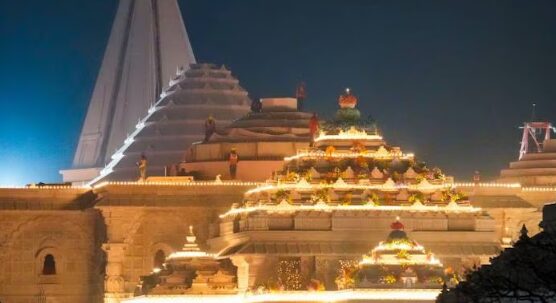
₹1800 cr will be spent, no iron used: ten fascinating facts about the Ram temple in Ayodhya
The entire city of Ayodhya is filled with holy energy as the consecration event is just one day away.

On January 22, the Ram Temple in Ayodhya is scheduled to hold its Pran Pratishtha. This sacred rite, which commemorates the deity’s dedication within the temple, is expected to be a momentous occasion with great cultural and symbolic significance. A group of priests led by Lakshmikant Dixit will perform the Pran Pratishtha rite, which Prime Minister Narendra Modi will preside over. To honor the anniversary, a number of states have declared Monday a public holiday or a half-day off.
Ten fascinating facts about the Ram Temple in Ayodhya are listed below:
- At 2.7 acres in all, the Ram temple at Ayodhya is a large structure. The temple’s remarkable 57,400 square feet of built-up space demonstrate the scope and magnificence of the architectural project.
- The temple’s dimensions, measuring 235 feet in breadth and 360 feet in total length, are remarkable. When the summit is included, the temple’s total height is 161 feet. This substantial building is three stories tall, with a 20-foot ceiling on each story.
- A sizable number of columns support the temple’s foundation. There are 160 columns supporting the ground floor and 132 supporting the upper story. The temple’s overall solidity and beauty are enhanced by the 74 columns that support the second level, which features elaborate design and decoration.
- The temple is built with three stories, each standing to a height of twenty feet. The careful arrangement of space makes it possible to incorporate a variety of ceremonial and practical sections, adding to the temple’s adaptability and significance.
- In addition to its religious significance, the Ram temple is meant to serve as a center of culture. The incorporation of educational rooms and meditation places is indicative of a comprehensive strategy towards the temple’s role in promoting spiritual, cultural, and educational endeavors.
- By eschewing the use of steel or iron, the Ram Mandir in Ayodhya was built using a novel technique. Rather of utilizing modern building materials, the project adheres to traditional building methods and shows a dedication to sustainability.
- Bansi Paharpur Pink Sandstone from Rajasthan’s Bharatpur area is used in the main temple building. The plinths are made of granite stones, giving the temple a strong and enduring base. Granite is used, which contributes to the temple’s overall lifespan and adds structural strength. For the inlay work, colored and white Makrana marble are employed in elaborate patterns.
- The building uses unique bricks called “Ram Shilas,” which have the words “Shri Ram” engraved on them. These bricks link the contemporary workmanship of the temple with historical meaning by creating a symbolic parallel with the stones thought to have been used in the construction of Ram Setu.
- Shaligram Rock, a well regarded fossil found in the Gandaki River in Nepal, forms part of the structure. The temple has a more spiritual feel to it because of the Shaligram, which is venerated in Hinduism and is thought to be a symbol of Lord Vishnu.
- The Shri Ram Janmabhoomi Teerth Kshetra calculated that the construction of the architectural wonder will cost ₹1,800 crore. The pursuit of building the Ram Temple was claimed to have cost ₹900 crore between February 5, 2020 and March 31, 2023.